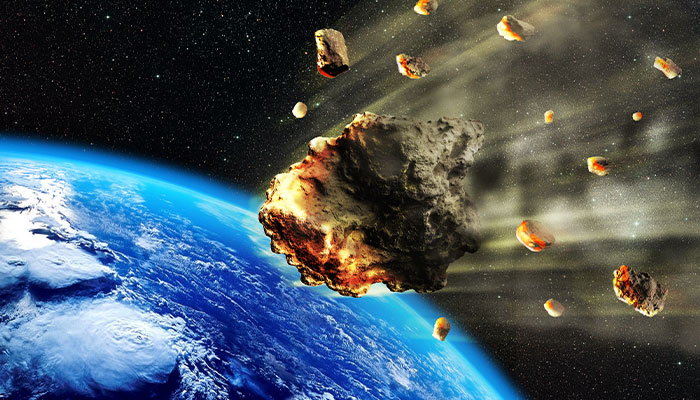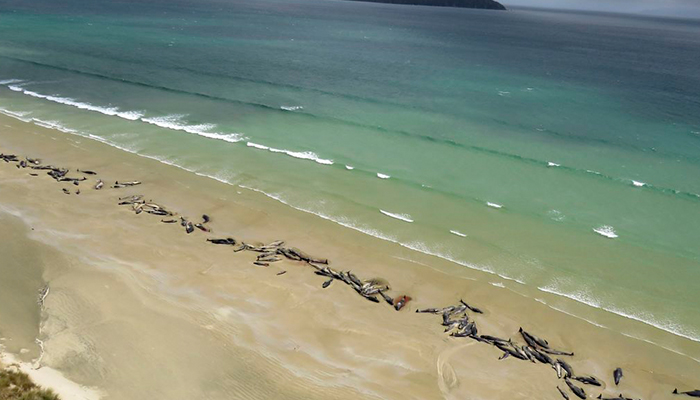There’s a lot of water on Earth, but how did it get here? One hypothesis was that it was dumped here by asteroids formed in our solar system’s infancy.

Incoming: A digitally rendered image of meteorites heading towards Earth ... Professor Turner and his colleagues used samples from meteorites that had been observed falling.
Now Macquarie University isotope geochemist Professor Simon Turner and colleagues from France and the USA have performed an ingenious study to shed light on the question.
Their findings were recently published in Science, and strongly imply that the asteroids these meteorites came from are not solid rock, but frozen balls of mud which still contain ice.
It is significant in both scientific and (prospectively) practical terms, Turner says.
This would be a huge advantage for space exploration, or, in a worst-case scenario, a means of supplementing Earth’s supplies of fresh water.
"Not only does it provide strong evidence to support the hypothesis that Earth’s water originated in asteroids, it also holds potential for mining asteroids for water in future," he says.
"This would be a huge advantage for space exploration, or, in a worst-case scenario, a means of supplementing Earth’s supplies of fresh water."
Asteroids, thankfully, are not prone to falling on Earth. But chunks of them often fly off and fall to Earth as meteorites. Turner and his team used samples of a particular kind of meteorite – carbonaceous chondrites – which represent around four to five per cent of all known meteorites.
These are relatively porous, meaning they can hold substances within them. Minerals have been found in these meteorites which only appear in the presence of water and other organic compounds. Carbonaceous chondrites are also very old, probably at least as old as Earth itself, with some appearing to be even more ancient.
As one of the most primitive objects in the solar system, they can provide valuable insights into the conditions during the earliest days of the solar system. They are also a leading candidate for being the delivery system for Earth’s water.
Unlocking the liquid timeline
Scientists already knew that there was fluid flow on carbonaceous chondrites at some stage, but not when. Previous dating methods showed water was present on these rocks early — around 4.5 billion years ago, shortly after Earth formed.

Water, water everywhere: Scientists have found strong evidence to support the hypothesis that Earth's water originated in asteroids.
Turner and his colleagues used samples from meteorites that had been observed falling. This gave them a date of arrival. And since the samples had been collected within days of their arrival on Earth, it also enabled them to rule out environmental contamination by the water in our atmosphere.
Then they calculated the water flow timeline using uranium-thorium dating, a technique which uses isotopes of these elements to establish age. They were not looking for the age of these meteorites, but for when liquid was moving in the rock.
When liquid flows, it moves isotopes with it, leaving a short-term (in the geological sense) record of the flow. That record only lasts about a million years. Because uranium is very soluble in fluid, and thorium (an element formed from the decay of uranium) is not, fluid flow within the rock would separate the two.
- Can you really make friends with an octopus?
- Telehealth is here to stay as patients phone their GPs in droves
Crucially, thorium has a half-life of 75,400 years. After somewhere between several hundred thousand and a million years, it will have decayed beyond the ability to measure it effectively.
Every one of the carbonaceous chondrites the team tested had isotope ratios indicating that liquid water had flowed through them in that period.
“No-one had thought of analysing U-series isotopes in meteorites before, because it was assumed that they had not undergone chemical disturbance for billions of years”, says Turner. “So we might have been seen as crazy but the results proved otherwise.”
Simon Turner is Distinguished Professor in the Department of Earth and Environmental Sciences and Director of Macquarie's Thermo Fisher isotope development hub.



